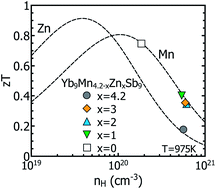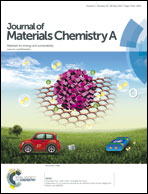Thermoelectric properties of the Yb9Mn4.2−xZnxSb9 solid solutions†
Abstract
Yb9Mn4.2Sb9 has been shown to have extremely low thermal conductivity and a high thermoelectric figure of merit attributed to its complex crystal structure and disordered interstitial sites. Motivated by previous work which shows that isoelectronic substitution of Mn by Zn leads to higher mobility by reducing spin disorder scattering, this study investigates the thermoelectric properties of the solid solution, Yb9Mn4.2−xZnxSb9 (x = 0, 1, 2, 3 and 4.2). Measurements of the Hall mobility at high temperatures (up to 1000 K) show that the mobility can be increased by more than a factor of 3 by substituting Zn into Mn sites. This increase is explained by the reduction of the valence band effective mass with increasing Zn, leading to a slightly improved thermoelectric quality factor relative to Yb9Mn4.2Sb9. However, increasing the Zn-content also increases the p-type carrier concentration, leading to metallic behavior with low Seebeck coefficients and high electrical conductivity. Varying the filling of the interstitial site in Yb9Zn4+ySb9 (y = 0.2, 0.3, 0.4 and 0.5) was attempted, but the carrier concentration (∼1021 cm−3 at 300 K) and Seebeck coefficients remained constant, suggesting that the phase width of Yb9Zn4+ySb9 is quite narrow.


 Please wait while we load your content...
Please wait while we load your content...